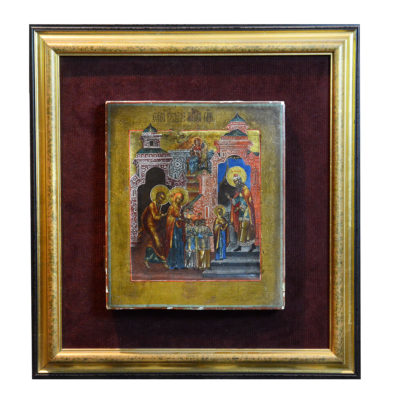
| SKU | PF.4852 |
|---|---|
| Circa | 1750 AD to 1900 AD |
| Dimensions | 12.25″ (31.1cm) high x 10.75″ (27.3cm) wide |
| Medium | Wood |
| Origin | Russia |
| Gallery Location | USA |
Russians inherited the tradition of icon painting from Byzantium, where it began as an offshoot of the mosaic and fresco tradition. During the 8th and 9th centuries, the iconoclastic controversy in the Orthodox Church called into question whether religious images were a legitimate practice or sacrilegious idolatry. Although the use of images was in the end permitted, a thorough distinction between profane art intended to depict reality and sacred art designed for spiritual contemplation was established. That difference is one of the reasons that the artistic style of icons can seem so invariant. Certain kinds of balance and harmony became established as reflections of divinity, and as such they invited careful reproduction and subtle refinement rather than striking novelty. Although this philosophy resulted in a comparatively slow evolution of style, icon painting evolved considerably over the centuries. Unlike the pictorial traditions of the west that aspire towards increased realism and naturalism, the essence of Russian icon painting is not about the representation of physical space or appearance. Icons are images intended to aid in contemplative prayer, and in that sense, are more concerned with conveying meditative harmony than with laying out a realistic scene. They were not painted to please the eye of the mind, but to inspire reflection and self-examination.
Tradition has it that Anna, wife of Joachim, childless for many years, reached a point in her life just short of despair when she prayed in earnest that God grant her a child. In order to court God’s favor, she promised that, should her wish be fulfilled, she would pledge the child to his holy Temple. God granted her this child, named Mary, and faithful to her word, Anna presented her daughter to the temple and entrusted her care to the high priest Zacharias. This is the scene depicted on this marvelous icon. The infant Mary, bearing a halo foretelling of her divinity, has left the side of her mother and approaches the high priest Zacharias who will serve as her spiritual guide. The young child is caught in a transition between the domestic world of her humble family and the religious structure of the Jewish temple. This temple, suggested by the architectural elements in the background, is the center of Mary’s religious education. By the time she was released to her parents, the saintly Mary was not only a flawless maiden but in her twelve years had acquired the lore and religious fervor of the deepest scholars, something usually denied a female child of those days. This icon is a stunning document to this vital transition in the life of the Virgin. Inside the temple, Mary received an education that would ultimately prepare her to become the mother of god. However, here she is depicted as a little girl, her holiness already apparent to us, who is leaving the security of her family to devote herself to a greater calling: God’s will.
Login to view price
Sign-up to receive the latest Wedding Estates news and promotions!

